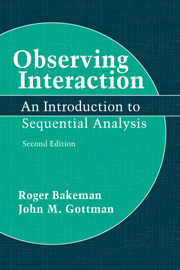Book contents
- Frontmatter
- Contents
- Preface to the second edition
- Preface to the first edition
- 1 Introduction
- 2 Developing a coding scheme
- 3 Recording behavioral sequences
- 4 Assessing observer agreement
- 5 Representing observational data
- 6 Analyzing sequential data: First steps
- 7 Analyzing event sequences
- 8 Issues in sequential analysis
- 9 Analyzing time sequences
- 10 Analyzing cross-classified events
- 11 Epilogue
- Appendix: A Pascal program to compute kappa and weighted kappa
- References
- Index
5 - Representing observational data
Published online by Cambridge University Press: 13 October 2009
- Frontmatter
- Contents
- Preface to the second edition
- Preface to the first edition
- 1 Introduction
- 2 Developing a coding scheme
- 3 Recording behavioral sequences
- 4 Assessing observer agreement
- 5 Representing observational data
- 6 Analyzing sequential data: First steps
- 7 Analyzing event sequences
- 8 Issues in sequential analysis
- 9 Analyzing time sequences
- 10 Analyzing cross-classified events
- 11 Epilogue
- Appendix: A Pascal program to compute kappa and weighted kappa
- References
- Index
Summary
Representing versus recording
When observational data are being recorded, it is reasonable that practical concerns dictate what is done. One uses whatever equipment is available and convenient. One records in ways that are easy and natural for the human observers. One tries to preserve in some form the information that seems important. Thus recorded data can appear in literally a multitude of forms. Some of these were described in chapter 3; however, we recognize that what investigators actually do often combines the simple forms described there into more complex, hybrid forms.
However, the form used for data recording – the data as collected – should not become a straitjacket for the analysis to follow. A format that works well for data recording may not work so well for data analysis, and a format that works well for one analysis may not work well for another analysis. The solution is to figure out simple ways to represent data, ways that make different kinds of analysis simple and straightforward. There is nothing especially sacrosanct about the form of the recorded data, after all, and there is no merit in preserving that form when it proves awkward for subsequent uses.
It would be very useful if just a few relatively standard forms for representing observational data could be defined. Not only would this help to standardize terminology with respect to sequential analysis, thus facilitating communication, it would also make analysis easier and would facilitate designing and writing general-purpose computer programs for sequential analysis.
- Type
- Chapter
- Information
- Observing InteractionAn Introduction to Sequential Analysis, pp. 81 - 90Publisher: Cambridge University PressPrint publication year: 1997



